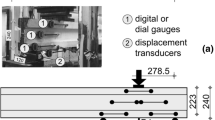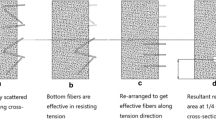Abstract
This is the second part of two papers on the experimental (Part I) and theoretical (Part II) resistance of steel fibre reinforced precast concrete beams.
High strength steel wire, and thin amorphous metal fibres have been introduced into prestressed concrete X beams in order to study their behaviour under shear loads. Experimental tests have determined shear strengths at the ultimate and cracking loads, and shown increased ductility with up to 2% fibre content. From these tests two different methods are proposed for predicting the ultimate shear capacity—these are the fibre supplement additive method, and the modified FRC principal tensile stress method. The principal tensile strength of the fibre reinforced concrete is given as a function of compressive strength and fibre volume. The means value of the ratio of the calculated to the test strength is 0.89 without partial safety factors, and, being conservative, is proposed for use in design. A calculation model is presented.
Résumé
Cette partie est la deuxième de deux articles sur les expériences (part I) et la théorie (partie II) sur la résistance des poutres en béton préfabriqué renforcé de fibres d'acier.
Des aciers à haute adhérence et de minces fibres métalliques amorphes ont été introduits dans des poutres X en béton précontraint pour étudier leur comportement sous l'action des efforts tranchants. Des essais expérimentaux ont déterminé la résistance ultime au cisaillement et les charges de fissuration, et ont montré une hausse de la ductilité avec un volume allant jusqu'à 2% de fibres. Sur la base de ces essais, deux méthodes différentes sont proposées pour la prédiction de la résistance ultime au cisaillement—la méthode des fibres supplémentaires additionnelles et la méthode de la contrainte de tension principale du béton de fibres d'acier. La résistance principale en tension du béton renforcé de fibres est donnée comme fonction de la résistance à la compression et du volume de fibres. La valeur moyenne du rapport entre la résistance calculée et celle donnée par les essais est de 0,89 sans facteur de majoration, et, étant conservatrice, elle est proposée comme méthode de calcul. Le modèle de calcul est présenté.
Similar content being viewed by others
References
Narayanan, R. and Darwish, I. Y. S., ‘Shear in prestressed concrete beams containing steel fibres’,International Journal of Cement Composites and Lightweight Concrete 9 (1987) 81–90.
Abdul-Wahab, H. M. S. and Al-Kadhimi, S. G., ‘Effect of SFRC on shar strength of prestressed concrete beams’,Magazine of Concrete Research 52 (1) (2000) 43–51.
Lorentsen, M., ‘Steel fibre concrete for structural elements’, in steel Fiber Concrete, US—Sweden Joint Seminar, 3–5 June 1985, Stockholm, Sweden (1985), 421–442.
Balaguru, P. N. and Ezeldin, A. S., ‘Behaviour of partially prestressed beams made with high strength fiber reinforced concrete’, in ACI SP105-Fiber Reinforced Concrete Properties and Applications, (1987) 419–434.
Shin, S. W., Oh, J. G. and Ghosh, S. K., ‘Shear behaviour of laboratory-sized high strength concrete beams reinforced with bars and steel fibers’, ACI SP142—Fiber Reinforced Concrete-Developments and Innovations, (1994) 187–200.
Furlan, Jr, S. and de Hanai, J. B., ‘Prestressed fibre reinforced concrete beams with reduced ratios of shear reinforcement’,Cement and Concrete Composites 21 (1999) 213–221.
Rajagopal, R. S. and Siddappa, S., ‘Experimental investigation on fiber reinforced prestressed concrete beams under shear’, in ‘Fibre Reinforced Cement and Concrete’, Proceedings of the 4th International Symposium, Sheffield, July 1992 (RILEM 1992) 544–570.
Tan, K., Paramasivam, P. and Murugappan, K., ‘Steel fibers as shear reinforcement in partially prestressed beams’,ACI Structural Journal 92 (6) (1995) 643–652.
Swamy, R. N. and Bahia, H. M., ‘Influence of fiber reinforcement on the dowel resistance to shear’,ACI Journal 76 (2) (1979) 326–355.
ACI Committee 318, ‘Building Code requirements for Reinforced Concrete’ ACI 318-89 American Concrete Institute, Michigan, USA (1989).
Casanova, P., Rossi, P. and Schaller, I., ‘Can steel fibers replace transverse reinforcements in reinforced concrete beams’,ACI Materials Journal 94 (5) (1997) 341–354.
Lim, T. Y., Paramasivam, P. and Lee, S. L., ‘Analytical model for tensile behaviour of steel-fiber concerte’,ACI Materials Journal 84 (4) (1987) 286–298.
Dramix Guidelines, ‘Design of Concrete Structures. Steel Wire Fibre Reinforced Concrete Structures with or without Ordinary Reinforcement’, Final Draft, (1995).
Nemegeer, D. and Tatnall, P. C., ‘Measuring Toughness Characteristics of SFRC—A critical View of ASTM C1018, ACI SP-155’, Testing of Fibre Reinforced Concrete, (1995).
Swamy, R. N. and Bahia, H. M., ‘The effective of steel fibres as shear reinforcement’,Concrete Intermational 7 (3) (1985) 35–40.
Narayanan, R. and Darwish, I. Y. S., ‘Use of steel fibres as shear reinforcement’,ACI Structural Journal 84 (3) (1987) 216–227.
Ashour, S. A., Hasanian, G. S. and Wafa, F. F., ‘Shear behaviour of high-strength fiber reinforced concrete beams’,ACI Structural Journal 89 (2) (1992) 176–184.
BS 8110, Structural Use of Concrete, Part 1, Code of Practice for Design and Construction’, British Standards Institution, London (1985).
Eurocode 2: ‘Design of Concrete Structures—Part 1: General Rules and Rules for Buildings’, EN 1992-1-1 (2001).
Fédération Internationale de la Précontrainte, ‘Precast Prestressed Hollow Core Floors’, Thomas Telford, London (1988).
PCI ‘Manual for the Design of Hollow Cored Slabs.’ Prestressed Concrete Institute Illinois, USA, (1991).
Stang, H. and Aarre, T., ‘Evaluation of crack width in FRC with conventional reinforcement’,Cement and Concrete Composites 14 (1992) 143–154.
Paine, K., ‘Steel fibre reinforced concrete for prestressed hollow core slabs’, Ph.D. Thesis, University of Nottingham, UK, (1998).
Li, V. C., Stang, H. and Krenchel, H., ‘Micromechanics of crack bridging in fibre-reinforced concrete’,Mater. Struc. 26 (1993) 486–494.
Mansur, M. A., Ong, K. C. G. and Paramassivam, P., ‘Shear strength of fibrous concrete beams without stirrups’,Journal of Structural Engineering, ASCE 112 (9) (1986) 2066–2079.
Fattuhi, N., ‘Reinforced corbels made with plain and fibrous concrete’,ACI Structural Journal 91 (5) (1994) 530–536.
Boucharet, J.-M., Personal Communication (1997).
Girhammar, U.-A., ‘Design principles for simply-supported prestressed hollow core slabs’,Structural Engineering Review 4 (4) (1992) 301–316.
Author information
Authors and Affiliations
Rights and permissions
About this article
Cite this article
Elliott, K.S., Peaston, C.H. & Paine, K.A. Experimental and theoretical investigation of the shear resistance of steel fibre reinforced prestressed concrete X-beams—Part II: Theoretical analysis and comparison with experiments. Mat. Struct. 35, 528–535 (2002). https://doi.org/10.1007/BF02483120
Received:
Accepted:
Issue Date:
DOI: https://doi.org/10.1007/BF02483120




